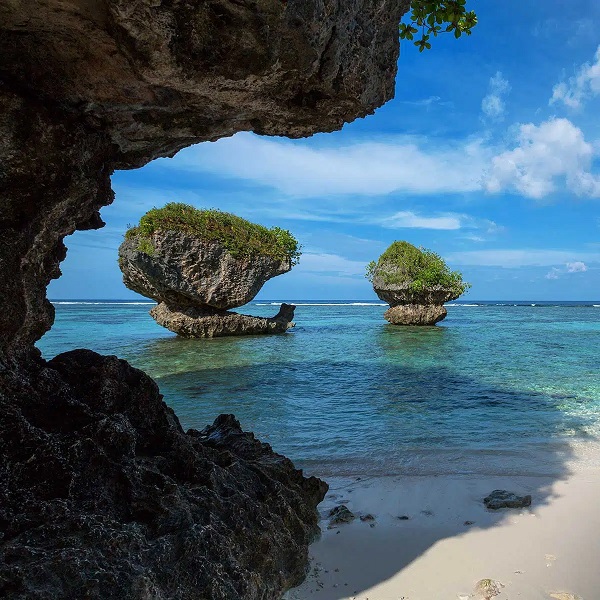
Saturday, August 24, 2024
Reading Time: 3 minutes 
Coral reefs are a vital part of Guam’s ecosystem, offering protection to the island’s coastline and supporting both the local culture and economy. These reefs act as natural barriers, reducing the impact of storm surges, coastal erosion, and high waves during events like tsunamis, tropical storms, and typhoons. Without these coral reefs, wave heights could reach between four to 12 meters, but with the reefs in place, they are significantly reduced to between two and six meters. This reduction in wave energy can save up to $8 million annually in potential damages to coastal structures, including hotels and businesses.
In addition to their protective role, coral reefs are essential for the island’s fishing industry, which holds cultural and sustenance significance for the CHamoru people and immigrant communities. Fishing remains a key activity, with fish often caught for special events such as weddings, funerals, and fiestas. Surveys indicate that 65% of local fishermen engage in fishing for enjoyment and cultural identity, while 18% fish primarily to provide food for their families.
Tourism’s Role in Guam’s Economy
Tourism is a cornerstone of Guam’s economy, accounting for over 50% of the island’s revenue and generating more than $1.5 billion annually. One in three jobs on the island is tied to the tourism sector. In 2016, Guam welcomed over 1.5 million visitors, drawn by the island’s stunning beaches, coral reefs, and outdoor activities. Marine-based activities such as snorkeling, scuba diving, and jet skiing contribute significantly to the tourism industry, with 28% of tourist revenue linked to these activities.
Direct Impacts of Tourism on Coral Reefs
Tourism, while beneficial to the economy, can negatively impact coral reefs. Snorkelers and scuba divers, especially beginners, often cause damage to the reefs through actions like fin strikes, grabbing, and standing on corals. With approximately 300,000 dives recorded annually in Guam, and two-thirds of these dives by tourists, the pressure on the reefs is substantial. Inexperienced divers and snorkelers, guided by instructors who may encourage contact with corals for photo opportunities, often inflict unintentional damage. This not only physically harms the coral but also makes them more susceptible to diseases.
Seagrass beds, which serve as nurseries for many fish species, are also at risk from tourism-related activities. Divers and snorkelers walking on these beds can uproot and break the seagrass, leading to long-term ecological impacts, such as reduced fish abundance and diversity.
Indirect Impacts of Tourism
Tourism’s indirect effects on coral reefs are equally concerning. Activities like kicking up sediment, feeding fish, and using toxic sunscreens can all harm the reefs. Sediment kicked up by tourists can smother corals and block essential sunlight, inhibiting coral growth and reproduction. Fish feeding disrupts the natural behavior of reef fish, which can lead to ecological imbalances, such as algal overgrowth. Sunscreen pollution, another indirect impact, affects nearly 10% of coral reefs globally, increasing the risk of viral infections, killing coral larvae, and exacerbating coral bleaching.
Steps to Minimize Tourism’s Impact
Efforts to mitigate the negative effects of tourism on Guam’s reefs include involving the tourism industry in sustainable coral reef management and implementing fees for activities like snorkeling and diving, which would fund reef protection efforts. Educating tourists, especially snorkelers and divers, is crucial. Dive shops can play a key role by providing pre-dive briefings on reef-friendly practices, and dive guides can lead by example and correct harmful behaviors underwater.
How You Can Help
Tourists can also take steps to reduce their impact on coral reefs. Using reef-safe sunscreen, wearing sun-protective clothing, and being mindful of where they walk while in the water can help protect these vital ecosystems. Practicing diving and snorkeling skills before venturing out to coral-rich areas can also minimize accidental damage.
Tourism undoubtedly has an impact on Guam’s coral reefs, but with responsible management and increased awareness, these effects can be mitigated, ensuring that the reefs continue to thrive and protect the island for generations to come.
Tags: Coastal Protection, coral reefs, guam, Guam reefs, Guam Tourism, marine ecosystem, pacific ocean, Pacific region, reef protection, sustainable tourism, Tourism, Travel, Travel News, U.S. island territory

